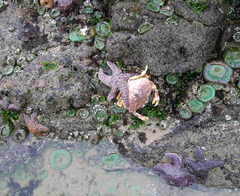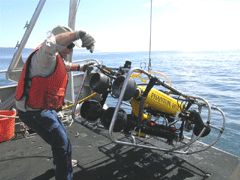Northwest Dead Zone
Air Date: Week of July 25, 2008

Seastars feasting on Dungeness crabs that succumbed to low oxygen conditions during 2004. (Photo: Jane Lubchenco)
There are about 200 oxygen depleted regions, or dead zones, in the world’s oceans. They occur when fertilizers and manure in runoff reach the sea, fueling algae that eats up all the oxygen. But a dead zone off the coast of the Pacific Northwest has scientists looking at a different culprit – climate change. Host Steve Curwood turns to Professor Jack Barth of Oregon State University to learn more about what might be behind the dead zone in the Northwest.
Transcript
CURWOOD: You’re listening to an encore edition of Living on Earth. I’m Steve Curwood. We like to picture the ocean as teeming with life – with fish and crabs and strange glowing eels. But in many parts of the world the ocean is dying. There are currently about 200 dead zones almost all of them caused by fertilizer or sewage run-off. But one dead zone off the coast of the Pacific Northwest has been expanding over the past few years, for causes that are harder to fathom. Joining me now is Professor Jack Barth of the College of Oceanic and Atmospheric Sciences at Oregon State University. Professor Barth, welcome to Living on Earth.
BARTH: Thank you, Steve.
CURWOOD: So the news is, the dead zone off of the Pacific Northwest might well be connected to climate change. How and why would that be?
BARTH: Well, we've seen low oxygen or hypoxia in these areas where there is significant green life die-off, so-called dead zones. We've seen that over the past five or six years, and we think that's unusual on the backdrop of about a fifty year's worth of data. So we're looking towards the cause, and we think there's a hint in the winds and how they're changing and how that affects these dead zones.

Screen capture showing carcasses of marine worms, sea cucumbers, crabs and other marine life killed by the loss of oxygen in nearshore reefs. (Photo: Oregon Department of Fish and Wildlife ROV)
BARTH: Well, this one's unusual because it's on an open coastline. It should be flushed regularly. There are no rivers putting nutrients in – that's the cause of most of the hypoxia zones around the world. Well it's all connected to the winds. The winds blow on the coast, they bring up these deepwaters from offshore, right in next to the coast. That fuels these phytoplankton blooms that then decompose and pull the oxygen out of the water. So we can go back to the winds, are the winds changing? And we know that with climate change there can be changes in the wind. Particularly they can increase in strength, so this whole scenario where we're producing lots of plankton that can decompose, that might be worse as we go into a climate change scenario.
CURWOOD: Why isn't this, you know, just something that's cyclical, that every ten or twenty, or maybe every fifty years this happens, the way you get other oscillations in the ocean, like the whole El Niño/La Niña phenomenon?
BARTH: Yeah, we were quite interested in that. There's a big ten-year change out here in the Pacific, and when we first saw this we said, ah ha that's just one of these ten-year swings. But having gone back over that fifty-year record, this recent five or six years really is unusual. So I can tell you that it's not part of a decadal, or a ten-year oscillation. Whether it's fifty or a hundred years, we don't know.

Dr. Hal Weeks deploying an Oregon Department of Fish and Wildlife robotic remotely operated vehicle to survey the effects of low oxygen zones along the Oregon coast. (Photo: Jane Lubchenco)
BARTH: Well, first thing you notice, there's lots of something called marine snow, this white, flocky material coming down from the surface. That's the plankton falling down that's gonna be decomposed and lead to the hypoxia. Next thing you notice is there aren't any fish in the area. So in all of our surveys in '06, we did not see any fish in this zone. Then you notice the piles and piles of Dungeness crab carcasses on the sea floor. Amongst them are sea worms that have come out from the bottom and are just flapping in the currents. Some of these majestic anemones, white, about two feet tall, starting to slump over from lack of oxygen. There usually are lots of sea star species. We saw some of those actually collapsing from lack of oxygen – so basically this wholesale area of nothing alive and lots of death.
CURWOOD: Going over a couple of articles written about your research, there was a story of some fisherman having crabs kind of jumping out of the water there? What's that all about?
BARTH: Yeah, what happens is those that can get away do. And what I saw myself is, my son and I go recreational crabbing, and we were in the bay near the dead zone and catching phenomenal sized crabs, sort of dinner plate sized in fifteen minutes or less. And those were the crabs that were running into shore, running into shallow water where there is oxygen. I've also heard reports of small octopi coming up the lines of the fisherman, trying to get out of that dead zone near the bottom of the water.
CURWOOD: And this isn't happening just off the Pacific Northwest. This is elsewhere on the planet.
BARTH: Yeah, we know of two other areas. There's – the area off Peru and Chile has a similar hypoxia zone. The one off South Africa and Namibia is quite interesting. They actually get walk-outs of lobsters onto the beach, fleeing the dead zone in that region.

Seastars feasting on Dungeness crabs that succumbed to low-oxygen conditions during 2004. (Photo: Jane Lubchenco)
BARTH: Yeah, that's exactly right. If you think about this whole process as fueling a healthy ecosystem, there was a balance there and now somehow we've pushed that a little too far, and as these dead zones develop the creatures are fleeing to the edges looking for oxygen refuges and concentrating, and we're really not sure what the ripple effect will be – will they be more subject to being preyed upon in those areas?
CURWOOD: Professor Jack Barth teaches at the College of Oceanic and Atmospheric Sciences at Oregon State University. Thanks so much, Jack.
BARTH: You're welcome, Steve.
Links
Click here to see more photos and read the Oregon State University team's work
Living on Earth wants to hear from you!
Living on Earth
62 Calef Highway, Suite 212
Lee, NH 03861
Telephone: 617-287-4121
E-mail: comments@loe.org
Newsletter [Click here]
Donate to Living on Earth!
Living on Earth is an independent media program and relies entirely on contributions from listeners and institutions supporting public service. Please donate now to preserve an independent environmental voice.
NewsletterLiving on Earth offers a weekly delivery of the show's rundown to your mailbox. Sign up for our newsletter today!
 Sailors For The Sea: Be the change you want to sea.
Sailors For The Sea: Be the change you want to sea.
 The Grantham Foundation for the Protection of the Environment: Committed to protecting and improving the health of the global environment.
The Grantham Foundation for the Protection of the Environment: Committed to protecting and improving the health of the global environment.
 Contribute to Living on Earth and receive, as our gift to you, an archival print of one of Mark Seth Lender's extraordinary wildlife photographs. Follow the link to see Mark's current collection of photographs.
Contribute to Living on Earth and receive, as our gift to you, an archival print of one of Mark Seth Lender's extraordinary wildlife photographs. Follow the link to see Mark's current collection of photographs.
 Buy a signed copy of Mark Seth Lender's book Smeagull the Seagull & support Living on Earth
Buy a signed copy of Mark Seth Lender's book Smeagull the Seagull & support Living on Earth

